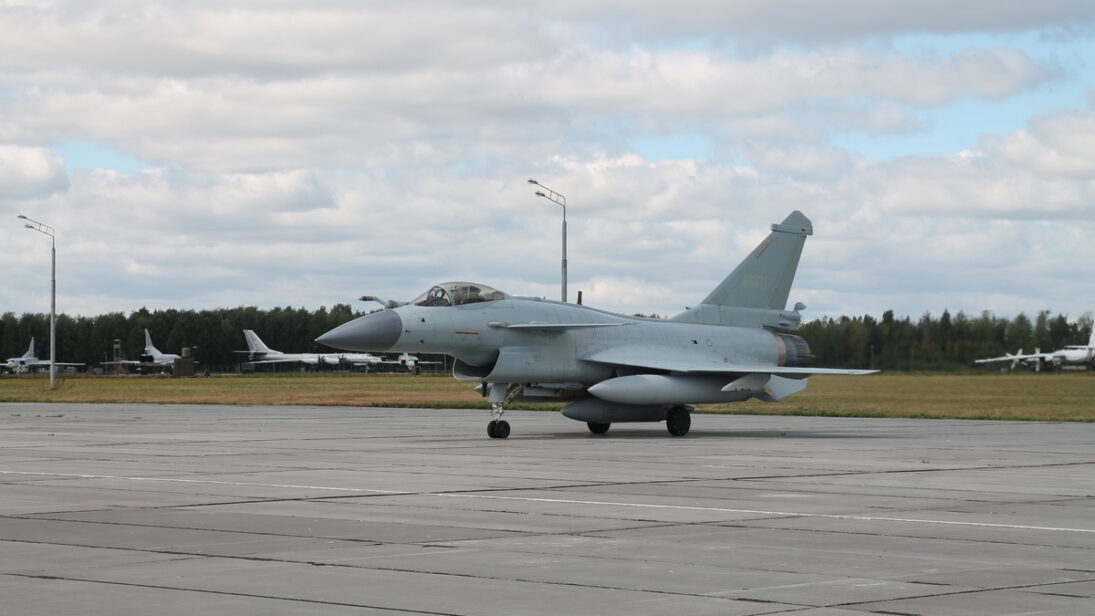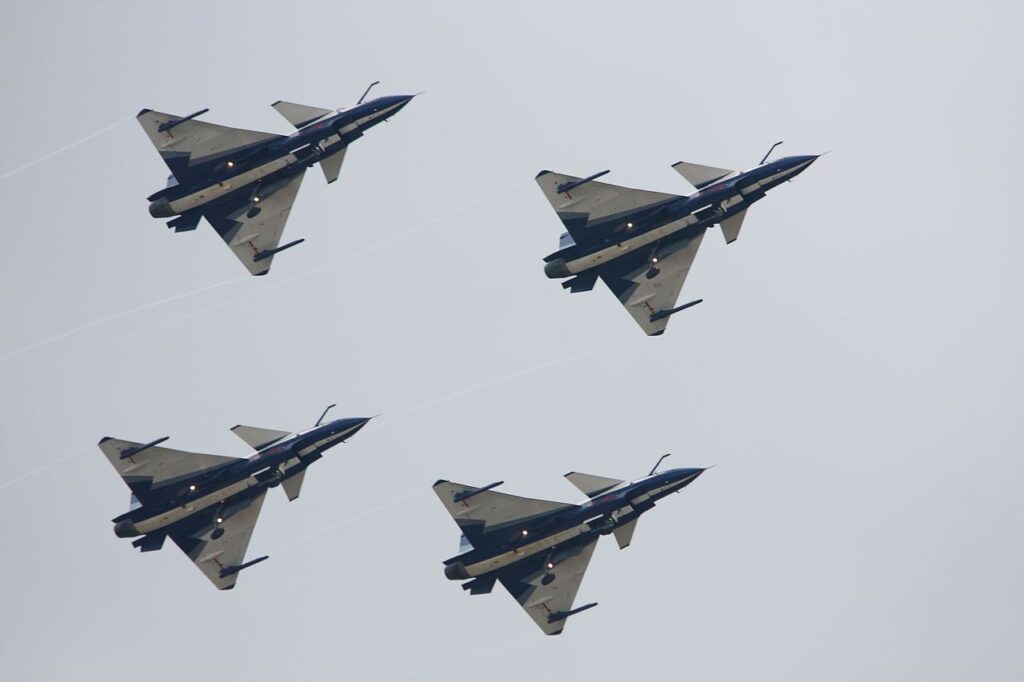
On March 23, at Pakistan’s Republic Day Parade, onlookers watched the first flyover of the recently inducted J-10C multi-role fighter. The purchase from China, announced publicly by Pakistan’s Interior Minister in late 2021, further showcases Pakistan-China defense ties and reflects the rising tensions in India and Pakistan’s conventional deterrence postures. Particularly in the three years since the aerial face-off during the Pulwama-Balakot episode, there has been a heightened focus on conventional military power. India has moved forward with strengthening its air power with the acquisition of the first batch of Rafale fighters from France in 2020 as well as strengthening missile defense with the S-400 purchase (expected to be operational this year) to counter threats posed from both Pakistan and China.
Pakistan, for its part, has moved forward with acquisition of the Chengdu J-10 fighter, which policymakers have asserted is meant to counter the Rafale. The J-10 can also be seen as a broader component of Pakistan strengthening its conventional deterrence posture, as it may replace some of the Pakistan Air Force’s aging fleet of fighters, and could potentially play a role in maritime operations. However, while conventional acquisitions may heighten a sense of security by addressing asymmetries and improving capabilities, it is also imperative that this be coupled with consistent regional dialogue or Confidence Building Measures—something that India and Pakistan have historically lacked.
Pakistan and the J-10 Fighter
Pakistan reportedly first showed interest in the J-10 in 2006, and the first iterations of the fighters date back to 1988 when China’s Chengdu Aircraft Corporation built the first model. The aircraft is a single-engine, multi-role jet which was also the first combat aircraft of Chinese origin meant to compete with Western and Russian capabilities. When the J-10 fighter was being developed, it was built to serve as an air-superiority fighter to counter Soviet fighter jets. However, the collapse of the Soviet Union altered China’s threat assessments and subsequently, the J-10 evolved into a multi-role jet with several variants. The most recent variant being the J-10C which has Active Electronically Scanned Array (AESA) and can carry missiles such as the air-to-air PL-15, presenting a long-range threat. The aircraft is also equipped with the Chinese-origin WS-10 turbofan engine. In addition, the J-10 fighter has a total of 11 hardpoints (which can carry heavy external loads like missiles), which includes five hardpoints on the fuselage and three hardpoints on each of the wings. The J-10 also can carry 1,300 gallons of fuel, with in-flight refueling capacity.
One of the main advantages of the J-10 is its widely applicable functionality. The J-10 fighter is equipped with surface attack capabilities. Apart from this, it is capable of tracking multiple targets simultaneously, and carrying short- and long-range missiles. Given the J-10’s advanced features and durability, Pakistan’s purchase suggests that it is looking to acquire capabilities that aim to compete with India conventionally.
The Utility of J-10 Fighter Jet for Conventional Deterrence
Pakistan’s purchase of the J-10 fighter from China has sparked some debate. One Pakistani senator questioned the logic of the purchase and raised investing in other defense areas, such as the JF-17, however, others have noted that the J-10 has a far wider utility for Pakistan Air Force’s (PAF) strategic needs. The timing and the signaling from Pakistan to India becomes essential for understanding motives. India has recently aquired the French-built Rafale fighter jets and the S-400 A2-AD system to bolster its air denial and offensive capabilities, and Pakistan’s political and military leadership has explicitly tied the acquisitions to addressing a conventional imbalance. While Pakistan’s Full Spectrum Deterrence posture has often been seen in light of its nuclear component—meant to deter an Indian conventional attack—Pakistan has also worked to respond to any major Indian military acquisition and deny air-superiority. With this in purview, Pakistan’s acquisition of the J-10 fighter conforms to the same logic of Pakistan’s denial of comprehensive advantage to India.

On the other hand, the J-10 fighter can also be relevant more broadly for the Pakistan Air Force as a suitable option for replacing Pakistan’s aging fleet of Mirage III Rose fighters. Since the J-10 is a multi-role fighter, it may also be operationalized for Pakistan’s Navy operations as well. Although, it has not been stated whether the J-10 would be used for naval operations in Pakistan, J-10 variants are used as part of the China’s naval arm. Because Pakistan is yet to have an aircraft which can carry out its maritime operations, the J-10 fits optimally in the overall conventional deterrence setting for Pakistan. Pakistan’s Navy has recently taken a stride to play a more responsive role in the Arabian Sea and the J-10 fighter which is capable of carrying anti-ship missiles can serve the Pakistan Navy’s interests.
The J-10 fighter can potentially fill gaps by being a suitable option to replace its aging fleet of fighter jets and update Pakistan’s existing operations. The acquisition is also coupled with other conventional advancements, including plans to induct block III variant of the JF-17 fighter.
Strategic Implications for Pakistan
The J-10 fighter deal also strengthens the ever-growing strategic partnership between Pakistan and China, its largest defense partner. Previously, the Pakistan Air Force’s front-runner fighter aircraft was the U.S built F-16 jet which has faced conditionalities over the years for its usage and supplies. A number of Pakistan and China’s regional interests with respect to India have aligned, therefore any potential conventional arms build-up for Pakistan will open a window for China to counter-balance India. As India’s recent military acquisitions are aimed at countering a two-front threat from China and Pakistan, China would seek to strengthen Pakistan’s conventional capabilities so that so it can effectively pressure India.
The root to stability lies in a dual-premised approach; a strong defense coupled with establishing consistent peace dialogues; something with which both the countries has struggled historically.
Keeping in view that it has been explicitly stated by Pakistan’s leadership that it is acquiring the J-10 fighter to counter India’s newly arrived Rafale aircraft, it is likely that this acquisition will be viewed critically in the Indian strategic circles. Both countries have robust conventional deterrence postures, but while conventional acquisitions may be designed to provide more response options or dissuade aggression, the assertive postures in the region also reflect the heightened threat perceptions. The root to stability lies in a dual-premised approach; a strong defense coupled with establishing consistent peace dialogues; something with which both the countries has struggled historically.
Crisis have repeatedly stalled any peace dialogue between both the countries while the conventional military buildup has seen a steady rise. The continuous trend of arms build-up by either of the two countries further narrows down the prospects of peace in a region fraught with threats to human security. The economic toll of these acquisitions is not suitable for either of the two countries given the pressing need to address challenges such as rising poverty or the need to address non-traditional security threats, put into focus with the onset of the COVID-19 pandemic. The most recent incident of the accidental missile launch from India towards Pakistan is indeed a classic case of how an unwanted accident can potentially bring two nuclear-armed countries to the brink of war. Therefore, it is essential that both the countries establish a regime of dialogue which can prevent any misunderstanding in case of a mishap, especially as conventional response options increase.
***
Image 1: via Wikimedia Commons
Image 2: via Wikimedia Commons


